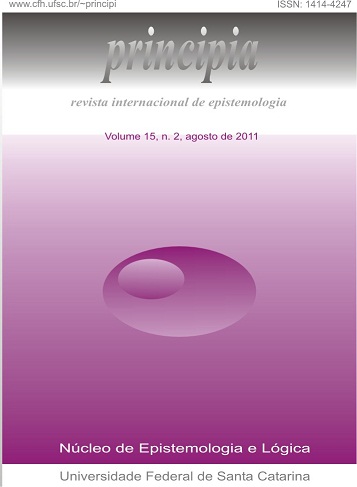On the Structure of Rationality in the Thought and Invention or Creation of Physical Theories
DOI:
https://doi.org/10.5007/1808-1711.2011v15n2p303Resumen
We want to consider anew the question, which is recurrent along the history of philosophy, of the relationship between rationality and mathematics, by inquiring to which extent the structuration of rationality, which ensures the unity of its function under a variety of forms (and even according to an evolution of these forms), could be considered as homeomorphic with that of mathematical thought, taken in its movement and made concrete in its theories. This idea, which is as old as philosophy itself, although it has not been dominant, has still been present to some degree in the thought of modern science, in Descartes as well as in Kant, Poincaré or Einstein (and a few other scientists and philosophers). It has been often harshly questioned, notably in the contemporaneous period, due to the failure of the logistic programme, as well as to the variety of “empirical” knowledges, and, in a general way, to the character of knowledges that show them as transitory, evolutive and mind-built. However, the analysis of scientific thought through its inventive and creative processes leads to characterize this thought as a type of rational form whose configurations can be detailed rather precisely. In this work we shall propose, first, a quick sketch of some philosophical requirements for such a research programme, among which the need for an harmonization, and even a conciliation, between the notions of rational (or rationality), of intuitive grasp and of creative thought. Then we shall examine some processes of creative scientific thought bearing on the knowledge and the understanding of the world, distinct from mathematics although keeping tight relations with them. Contemporary physical theories are privileged witnesses in this respect, for in them the rational thought of phenomena makes an intrinsic use of mathematical thought, which contributes to the structuration of the formers and to the expression of their concepts (which entails the physical contents of the latter). The General Theory of Relativity and the Quantum Theory are exemplar to this, as they directly reveal what can be called the “drag of physical thought par the mathematical form”, which makes possible to overcome the limitations of the physical knowledge previously adquired. This process is tightly related to the modalities and to the stucture of the rational thought underlying it. This is what we would like to show.
Descargas
Publicado
Número
Sección
Licencia

Principia http://www.periodicos.ufsc.br/index.php/principia/index is licenced under a Creative Commons - Atribuição-Uso Não-Comercial-Não a obras derivadas 3.0 Unported.
Base available in www.periodicos.ufsc.br.



